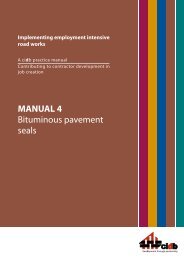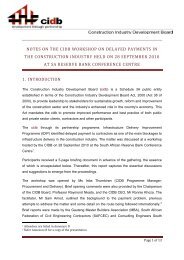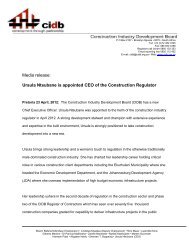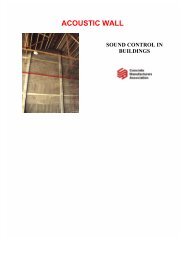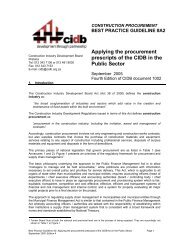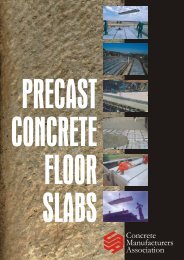Clay brick manufacture - Construction Industry Development Board
Clay brick manufacture - Construction Industry Development Board
Clay brick manufacture - Construction Industry Development Board
You also want an ePaper? Increase the reach of your titles
YUMPU automatically turns print PDFs into web optimized ePapers that Google loves.
Part 6<br />
CLEANING OF CLAY BRICKWORK<br />
PREVENTION IS BETTER THAN CURE: Cover face <strong>brick</strong>work during building or renovating<br />
6.1 GENERAL PRECAUTIONS<br />
operations to prevent mortar and paint stains.<br />
Staining can mar the appearance of <strong>brick</strong>work, but incorrect cleaning techniques can cause permanent<br />
damage. Consequently, any proposed method of cleaning should be tried out in a small unobtrusive<br />
area and left for at least a week to judge the results before the whole job is tackled. The techniques<br />
given here are intended for do-it-yourself work in removing relatively small areas of staining. A<br />
specialist contractor should be engaged for cleaning large areas of <strong>brick</strong>work.<br />
It is preferable to use wooden scrapers and stiff fibre brushes to avoid damaging the <strong>brick</strong>s but where<br />
chemicals are to be used, the <strong>brick</strong>work should be thoroughly wetted with clean water to prevent it<br />
absorbing the chemicals, and rinsed thoroughly with clean water afterwards. Adjacent features such<br />
as metal windows and the area at the foot of the wall should be protected from splashing of the<br />
chemicals.<br />
Many of the chemicals recommended are caustic, acidic or poisonous, so care should be taken and<br />
protective clothing and goggles should be worn. Volatile solvents should only be used indoors under<br />
conditions of good ventilation. It is essential to identify the type of stain or deposit before any cleaning<br />
operations are undertaken.<br />
6.2 PREPARATION<br />
Remember to thoroughly wet the <strong>brick</strong>work with clean water before applying any chemical, and wash<br />
down with clean water afterwards.<br />
Bricklaying should be managed carefully to prevent unsightly staining from mortar.<br />
6.3 MORTAR AND MORTAR SMEAR<br />
Where possible, remove larger pieces with a scraper, then wash down with a dilute solution of a<br />
proprietary acid cleaner. The <strong>manufacture</strong>r’s instructions must be strictly followed.<br />
• Wet the <strong>brick</strong>work thoroughly with water.<br />
• Remove mortar with a proprietary acid cleaner.<br />
• Remove any residual acid in the <strong>brick</strong>work by washing down with water.<br />
When removing mortar smear from <strong>brick</strong>work that has a potential to exhibit vanadium staining, the<br />
following final procedure is then recommended:<br />
• Treat the <strong>brick</strong>work with a 15 to 20% solution of Potassium Hydroxide to prevent the recurrence of<br />
the vanadium stain.<br />
Note: Light coloured face <strong>brick</strong>s are particularly susceptible to severe staining if too harsh an acid<br />
is used – please consult your <strong>brick</strong> <strong>manufacture</strong>r or the <strong>Clay</strong> Brick Association.<br />
35





